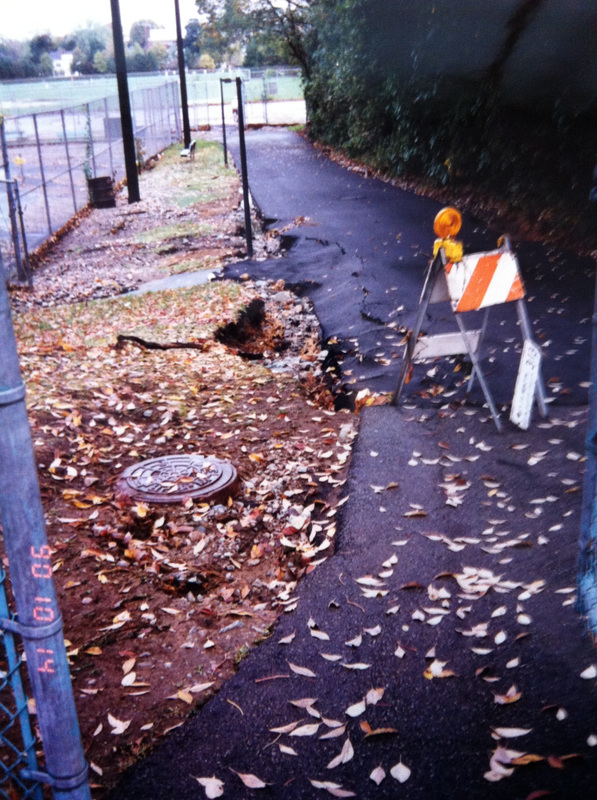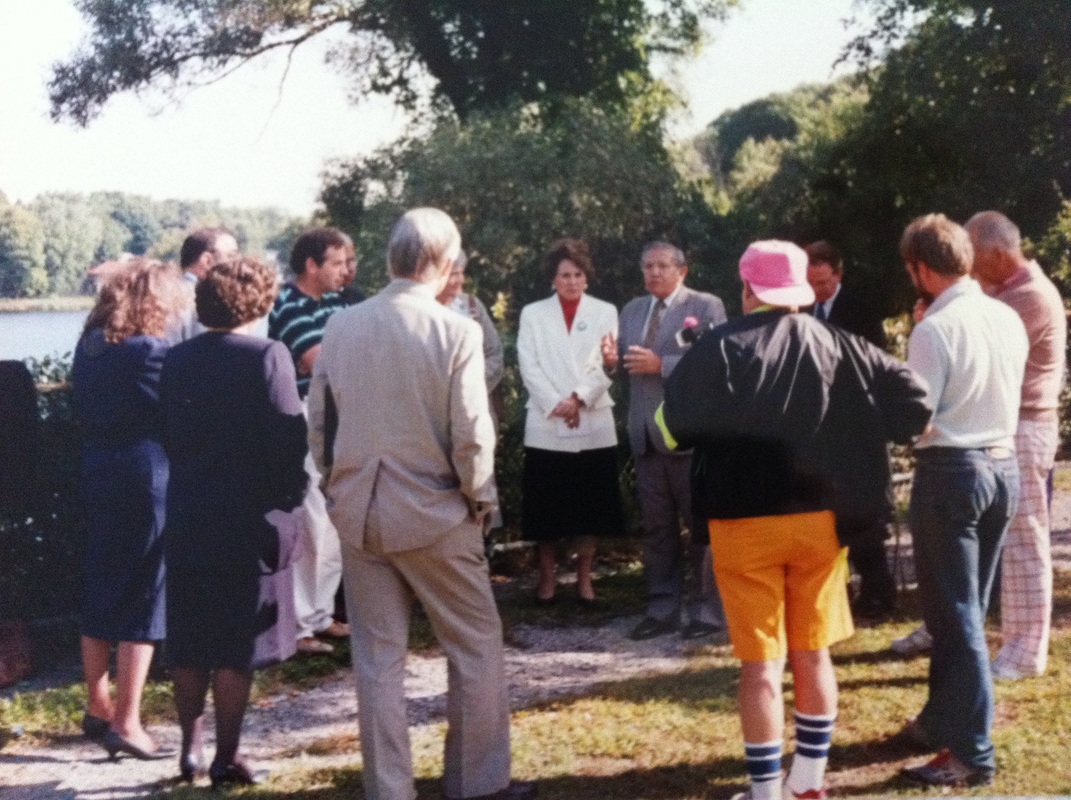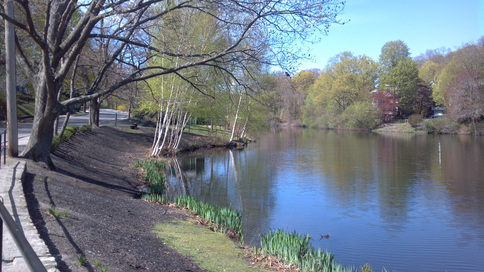“This beautiful sheet of water, like a sapphire gem set round with emeralds…” Samuel Francis Smith, History of Newton, Massachusetts, 1880
History...
The History of Bullough's Pond
The History of Bullough's Pond
|
In 1630, Newton was founded as a part of “Newtowne”, which included what is now Cambridge and Newton. The village that is now Newtonville was called Cambridge Village when, in 1664, John Spring built a dam across Smelt Brook to power his grist mill. A large pond formed behind the dam. Called “Spring’s Pond”, it is depicted in this 19th century painting. |
|
Newton incorporated as a town separate from Cambridge in 1688, and took the former name “Newtown” as its own in 1691. In this section of a map of Newton from 1700, the village of Newtonville is clearly marked, as is Spring’s mill and Spring’s Pond behind it. The orientation of this map has south at the top of the map. There are few roads, but Mill Lane (now Mill Street) is clearly visible at the bottom, or north end of the pond. Walnut Street, which will later bisect the pond, does not yet extend to the pond.
The descendants of John Spring ran the mill well into the 19th century. Newtonville began to grow at a more rapid pace after the introduction of railroad service from Boston in 1834 (image, below left). In 1835, John Bullough purchased a share in the mill. He kept a small grain storage building next to the new train station. Bullough also later lived in what was known as the “Miller’s House”, which still stands on Mill Street. By 1850, the pond was known as “Pearl Lake” rather than “Spring’s Pond”, and some time later it became “Bullough’s Pond”. |
|
By 1855, Newtonville had many new homes and residents, and they needed new roads to serve them. Walnut Street was extended south past Mill Street, bisecting Bullough’s Pond.
In this section of an 1855 map of Newton (image, right), the orientation has north at the top of the map. One can see Bullough’s Pond at the center bottom, cut in two by Walnut Street. The southern half of the pond would later be filled in and put into culverts, with remnants reappearing years later as the City Hall ponds and the library retention pools. In 1952, as part of an oral history project, an 86-year-old interviewee named Mrs. Hovenden drew a map of the mill (below, left), based on her childhood memories of trips there with her father in the 1870s when he needed to have rye from their West Newton farm ground into flour. Throughout the 19th century, winter ice was harvested from the pond for ice boxes in Newton homes (below, right). The ice was cut and stored in an icehouse on the bank, a precursor to the warming hut that stands there today. |
|
Vandals set a fire which destroyed the old mill in 1886. With no commercial incentive to maintain the pond, it became overgrown. The Newton Land and Improvement Company bought the pond and surrounding land, and restored the pond, the better to sell house lots around it. In 1897, the company gave the pond to the City as a recreational space, as Newton was changing steadily from a rural to a suburban area.
Frederick Law Olmstead designed the Newton stretch of Commonwealth Avenue, which was built in 1895, and included a trolley line from Boston to Norumbega Park. This photo (left), taken from the trolley waiting room around 1900, shows the pond at the intersection of Walnut and Commonwealth. |
|
In the 1890s, there were a number of street trolley lines running in Newton. One of them, the Newton & Boston Street Railway Company, ran a power plant on Cold Spring Brook.
The plant discharged hot oily water into the pond, which prevented safe skating ice from forming. In 1910, the City shut down the plant, restoring the pond to ice skating condition. The Newton city government displayed a deep commitment to ice skating on Bullough’s Pond from 1910 until well into the 1970s. The ice was cleared after snowstorms for skaters and hockey games. |
The City’s forestry department had oversight of Bullough’s Pond in 1910, and arranged with the Newton & Boston Street Railway Company to post signs on the front of trolleys advertising good ice skating conditions at Bullough’s Pond.
|
Ice skating was wildly popular at Bullough’s Pond for much of the 20th century. The City did an exceptional job of maintaining the pond and its banks to create the ideal conditions for safe skating ice formation. In this 1921 photo (at left), the hockey rink is visible in the pond’s northeast corner.
Citing the importance of Bullough’s Pond ice skating to the health of Newton residents, in 1926, the City paid to dredge the pond of silt build-up and to construct a new dam, culverts, weirs and storm drains (below, left). Ice skating continued on Bullough’s Pond in the 1930s (below), and 1940s. |
Newton City Hall was built in 1932. This aerial photo from 1935 (below, left) shows Bullough’s Pond from the perspective of City Hall. From this view, it is very evident that the City Hall pond that’s visible was once part of a larger Bullough’s Pond.
Ice skating and hockey continued throughout the 1950s (above, right) and 1960s. Bullough’s was so well maintained and the ice so reliable that the hockey team for Newton High School (now Newton North) played home games on the pond.
|
By 1981, when the photo at left was taken, ice skating was no longer common at Bullough's. The pond was silting up and becoming too shallow for thick ice formation. The water had begun to take on the greenish hue characteristic of algae proliferation and eutrophication. The pond was in trouble. Compare these two images, taken from the same spot. The one below left was taken in 1981, as the pond was becoming shallow and overgrown. The one below right was taken in 1989. Vegetation has grown up on the pond's silted edges, shrinking and choking it. |
|
In 1968, Bill and Betsy Leitch moved to the neighborhood near Bullough’s Pond. Beginning in the late 1970s, Betsy noticed the deteriorating condition of the pond. She and Bill founded the Bullough’s Pond Association in 1983 in an effort to encourage the preservation of this beautiful and historic Newton treasure. In this photo, taken in 1990, Betsy is demonstrating how shallow the pond has become from storm drain silting. Betsy led the BPA in campaigning for a dredging of the pond to preserve it as a nature-watching and recreational treasure, and to prevent downstream flooding.
The photo (below, left), taken during a partial draindown of the pond in 1989, shows how islands of silt have formed where storm drain pipes open into the center of the pond. By 1990, when this photo (below, right) was taken, eutrophication had led to the growth of a thick layer of algae and duckweed over the surface of the pond. |
|
A series of three heavy rainstorms in 1990 proved more than the silted-up and shallow Bullough’s Pond could absorb. Floodwaters spilled into Laundry Brook, overwhelming the culverts and storm drainage system. The thick layer of pond vegetation was swept downstream and deposited on residents’ property. Here (photo, right) the pond vegetation covers the collapsed remains of a backyard vegetable garden destroyed by the August 11, 1990 flooding. The flooding on August 11, 1990 was the worst of the three events. Debris was washed onto private property downstream of Bullough’s Pond (photo, below left). The photo (below right) shows Hull Street, next to the Laundry Brook culvert on August 11, 1990. The Bullough's Pond duckweed floats down the street with the floodwaters. |
|
The floodwaters that a silted and too-shallow Bullough's Pond couldn't contain flowed on, sweeping down Walnut Street towards the Newtonville shops. This photo (left) was taken at the intersection of Walnut and Cabot Streets at 4:00 PM on August 11, 1990. The stormwater swept over the Newton North tennis courts and playing fields on August 11, 1990 (below, left)… …and again on October 13, 1990 (below, right)… |
|
After almost a decade of activism, Betsy and Bill Leitch and the BPA were there in 1992 (photo, left) when then Mayor Theodore Mann and State Senator Lois Pines announced that funding and permits were in place to begin a major restoration of Bullough’s Pond. The project began in February 1993. It included dredging Bullough’s Pond, and improvements to the Laundry Brook drainage system. The following year, the Newton Conservators presented Betsy and Bill Leitch with the "Environmentalists of the Year" award for their leadership of the Bullough's Pond Association, and their decade-long efforts to restore and preserve the pond. |
Betsy Leitch and the Bullough's Pond Association next worked to remove an ugly chain-link fence that cut the pond off from the surrounding neighborhood, and to add plantings to shore up the pond's steep banks. For this beautification work, Betsy and Bill Leitch and the Bullough's Pond Association were presented with a prestigious gardening award.
The photos of Bullough’s Pond below were taken in 2013. The Bullough's Pond Association monitors changes in the pond’s depth in expectation of the need for future dredging. The Association has cared for the pond for more than 30 years, and our commitment to the preservation of this beautiful place is forever.






































